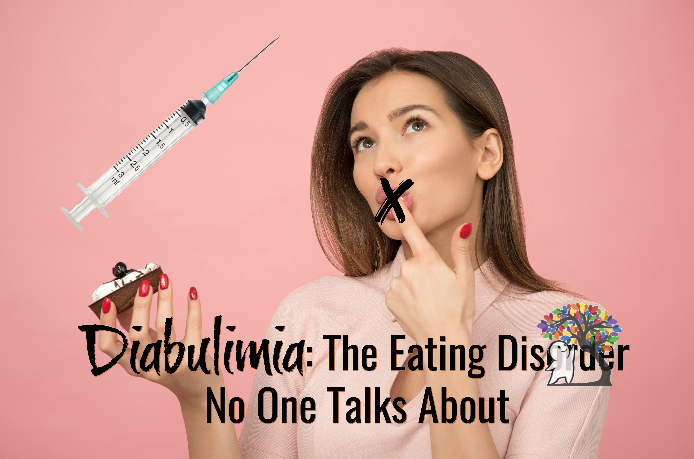Diabulimia – The Eating Disorder No One Talks About

Have you ever heard of diabulimia before? I never knew what it was until yesterday after watching a 30-minute documentary called Diabulimia: The World’s Most Dangerous Eating Disorder. After watching it I decided to do some research on the subject. Before going into detail, let me explain what diabulimia is. According to the National Eating Disorders Association its “a media-coined term that refers to an eating disorder in a person with diabetes, typically type I diabetes, wherein the person purposefully restricts insulin in order to lose weight (NEDA, 2018). In the medical world, doctors refer to diabulimia as ED-DMT1. This term refers to any type of eating disorder in people who have type 1 diabetes. The sad thing about this, diabulimia is not an official eating disorder.
 It can affect anyone no matter their age. But psychologist Dr. Marilyn Ritholz states that women with type 1 diabetes have 2x the risk of developing this disorder (Beyond Type 1). Although, men can experience it as well. The problem here is that the medication used to control diabetes may cause weight gain in some people, affecting their self-image.
It can affect anyone no matter their age. But psychologist Dr. Marilyn Ritholz states that women with type 1 diabetes have 2x the risk of developing this disorder (Beyond Type 1). Although, men can experience it as well. The problem here is that the medication used to control diabetes may cause weight gain in some people, affecting their self-image.
The symptoms experienced are:
- Obsession with food labels and numbers
- Low self-esteem
- Fixation on body image and weight
- Binge eating
- Self-induced vomiting
- Decreasing, delaying or not taking insulin
- Not eating in public
- Preoccupation with calories
- Depression and/or anxiety
- Fear that insulin will make them “fat”
- Excessive exercising
- Strict rules on eating
 There are also warning signs that loved ones can lookout for in those with diabulimia:
There are also warning signs that loved ones can lookout for in those with diabulimia:
- Moodiness
- Poor concentration and motivation
- Rapid weight loss
- Physical exhaustion
- Infrequent filled prescriptions
- Avoids injecting in front of people
- Low sodium and/or potassium
- High A1C, which is a blood test that provides information on person’s blood glucose level over the past three months (NIH – NIDDK, 2018).
- Frequent DKA (diabetic ketoacidosis), which is a complication where the body produces high levels of blood acids called ketones (Mayo Clinic, 2018). This occurs when the body isn’t producing enough insulin. The signs for DKA are: abdominal pain, nausea, vomiting, confusion, fatigue, and excessive thirst (Mayo Clinic, 2018).
![]() Diabulimia is a dangerous eating disorder because those battling with it decrease, delay, or stop taking their insulin. When this happens the body’s, organs become saturated with glucose (Beyond Type 1). If this isn’t corrected on time the person will develop complication from diabetes, such as (Mayo Clinic, 2018):
Diabulimia is a dangerous eating disorder because those battling with it decrease, delay, or stop taking their insulin. When this happens the body’s, organs become saturated with glucose (Beyond Type 1). If this isn’t corrected on time the person will develop complication from diabetes, such as (Mayo Clinic, 2018):
- Eye damage (retinopathy): this may lead to vision problems like cataracts or blindness.
- Nerve problems (neuropathy): leaving the person with numbness and/or pain on their hands and feet.
- Kidney damage (nephropathy): when severe the induvial will need frequent dialysis or a kidney transplant.
- Foot damage: such as the development of blisters and infections that can lead to foot or leg amputations.
- Hearing impairment: in some cases severe.
- Cardiovascular disease: such as stroke, heart attack and the narrowing of the arteries.
- Skin conditions: like bacterial or fungal infections.
 A multidisciplinary team composed of an endocrinologist, dietitian, psychiatrist, and a psychologist who specializes in eating disorders is needed to treat diabulimia. All these experts are needed because it is not only a mental health situation, but also a physical one. Traditional treatments can be ineffective for this disorder because it doesn’t take into consideration type 1 diabetes, along with its complications. Unfortunately, there aren’t many treatment centers that specialize in diabulimia. Due to this countless people who suffer don’t receive the adequate help they need.
A multidisciplinary team composed of an endocrinologist, dietitian, psychiatrist, and a psychologist who specializes in eating disorders is needed to treat diabulimia. All these experts are needed because it is not only a mental health situation, but also a physical one. Traditional treatments can be ineffective for this disorder because it doesn’t take into consideration type 1 diabetes, along with its complications. Unfortunately, there aren’t many treatment centers that specialize in diabulimia. Due to this countless people who suffer don’t receive the adequate help they need.
I believe this a valid eating disorder. It should be recognized in the medical and psychology field. Currently, I am a psychology student and not one of my professors has ever mentioned diabulimia to me. It took me by surprise when I saw the documentary about this eating disorder. There needs to be awareness because far too many diabulimia sufferers are falling in between the cracks of the system. Research needs to also be done to further understand this problem.
Help me spread the word by sharing this article. Society needs to become aware. If you or anyone you know may be struggling with this. Talk to a professional that is willing to listen and look into diabulimia. Don’t feel ashamed to ask for help.
Checkout Psych2Go’s book about Mental Health Recovery
 Check it out here: Mental Illness Recovery Book, “Something I truly enjoyed about this book is the simplicity and the variety of stories which are all focusing in one subject; mental illness. It’s amazing to see how this book connects each story to one another and to the reader. It provides a direct insight of living with mental illness and tips on how to overcome some disorders. If you feel lost, or if you want to help a friend or family member then this is the book for you.” -Carelyn
Check it out here: Mental Illness Recovery Book, “Something I truly enjoyed about this book is the simplicity and the variety of stories which are all focusing in one subject; mental illness. It’s amazing to see how this book connects each story to one another and to the reader. It provides a direct insight of living with mental illness and tips on how to overcome some disorders. If you feel lost, or if you want to help a friend or family member then this is the book for you.” -Carelyn
References
Beyond Type 1. (unknown). The Truth About Diabuimia. Retrieved from: https://beyondtype1.org/the-truth-about-diabulimia/
Mayo Clinic. (2018). Diabetic Ketoacidosis. Retrieved from: https://www.mayoclinic.org/diseases-conditions/diabetic-ketoacidosis/symptoms-causes/syc-20371551
National Eating Disorders Association – NEDA. (2018). Diabulimia. Retrieved from: https://www.nationaleatingdisorders.org/diabulimia-5
National Institute of Diabetes and Digestive and Kidney Diseases – NIDDK. (2018). The A1C Test & Diabetes. Retrieved from: https://www.niddk.nih.gov/health-information/diabetes/overview/tests-diagnosis/a1c-test#whatis





Currently if you state raise, and the vendor
or player learns it, next it’s a raise.